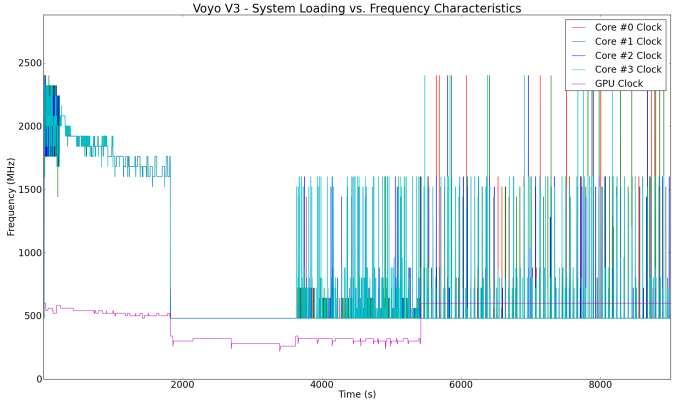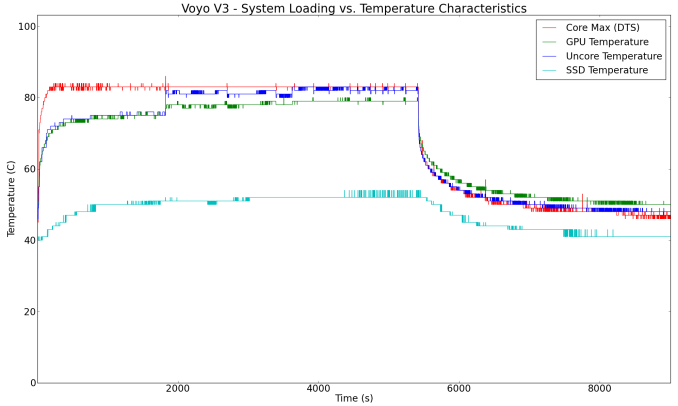Voyo V3 Review - A Fanless Intel Atom x7-Z8700 (Cherry Trail) mini-PC
by Ganesh T S on March 1, 2016 8:00 AM EST- Posted in
- Systems
- Intel
- Atom
- Passive Cooling
- Mini-PC
- Cherry Trail
Power Consumption and Thermal Performance
The power consumption at the wall was measured with a 1080p display being driven through the HDMI port. In the graphs below, we compare the idle and load power of the Voyo V3 with other low power PCs evaluated before. For load power consumption, we ran Furmark 1.12.0 and Prime95 v27.9 together. Given that the BIOS of the machine is not really optimized, the idle power being more than most comparable PCs is not surprising.


The load power consumption numbers can also be easily explained. The Atom x7-Z8700 has a SDP of only 2W, and it is definitely less power hungry compared to the Intel Celeron N3000 in the ASRock Beebox. However, it does lose out to the Bay Trail Compute Stick - this could be due to the power consumption of the extra components on the board such as the PCIe - SATA bridge and the faster clocks in the Cherry Trail SoC.
Our thermal stress routine starts with the system at idle, followed by 30 minutes of pure CPU loading. This is followed by another 30 minutes of both CPU and GPU being loaded simultaneously. After this, the CPU load gets removed, allowing the GPU to be loaded alone for another 30 minutes. The various clocks in the system as well as the temperatures within the unit are presented below.
The core clocks briefly operate at the maximum turbo frequency (2.4 GHz), but gradually scale down to the base clock (1.6 GHz) as the load is sustained. Thankfully, the thermal solution is decent enough to prevent the SoC from throttling. The GPU clock measurement has the usual Intel 'bug' where the measured clock is the maximum clock rate even when the GPU is not loaded. As soon as the GPU starts getting loaded, it moves between 200 - 300 MHz while keeping the power consumption of the whole system around 10 W.
According to the official specifications, the junction temperature of the Atom x7-Z8700 is 90C. Fortunately, after enabling DTS in the BIOS, we find that the maximum temperature of any of the board components is kept below 85C even under extreme stress.
Another important aspect to keep note of while evaluating fanless PCs is the chassis temperature. Using the Android version of the FLIR One thermal imager, we observed the chassis temperature after the CPU package temperature reached the steady state value in the above graph. Note that the picture below was taken after manually turning up the operating unit to expose the underside (metallic part abutting the black thermal film which covers the main board components).
We have additional thermal images in the gallery below.
The good part here is that even under extreme stress, the chassis doesn't heat up beyond 50 C. The bad part is that a lot of performance is left on the table (in terms of allowing the SoC to sustain turbo clocks for a longer duration) due to inefficient thermal design. Allowing for the metallic segment to be on top to aid convective cooling would have definitely helped in making the thermal performance better.



















69 Comments
View All Comments
Slawek - Tuesday, March 1, 2016 - link
I am not telling you to stop publishing PCMark 8, only to add Octane and Kraken. If published test says 'executed with Firefox 44' that is all information I need.Drumsticks - Wednesday, March 2, 2016 - link
Such a test wouldn't hold any value though. You can't make performance comparisons across generationswith different browsers. It might be useful to you but it's not a worthwhile test to run because there's no actual comparison to be made. A chart isn't worth making when outside variables can have a significant impact on the performance - is the 20% better performance of box A due to a 25% better browser engine/js performance? If so, that means the box is actually slower than the other comparison. And there's no way to know for sure where the benefit comes from.Samus - Tuesday, March 1, 2016 - link
It's hilarious seeing a shipping product not boot to OOBE. All they had to do was run a generalize SYSPREP and make a WIM image of the SSD...a process that hasn't changed since Windows Vista (a decade.)Doesn't this machines spec's qualify for Microsoft heavily subsidized/free Windows 10 Home license, or do they require a shipping storage capacity below 64GB SSD/4GB RAM?
ganeshts - Tuesday, March 1, 2016 - link
As I mentioned in another comment, it is likely that this unit does NOT qualify for the subsidized Win 10 install.I think the no-name Chinese manufacturers such as Voyo and Teclast need to step up the game - they have started shipping x86-based pre-built PCs only in the last couple of years, and they have lots to catch up on.
esterhasz - Thursday, March 3, 2016 - link
Apparently this activates, but only with a specific chinese version of windows (that can be set to English, though). Lon Seidman has a video on the issue on his channel.savagemike - Tuesday, March 1, 2016 - link
just as a point of interest if you check out Lon Seidman reviews on Youtube he has a couple videos reviewing this. He also had issues with the pre-installed Windows with UAC disabled. In the end he was able to install a Chinese version of Windows (from MS itself) which did activate OK. He did this on a tip from a viewer about a special program Microsoft has for Chinese manufacturers or something. The OS had an English language option for installation but he had to choose the Chinese version to make media from - from Microsoft.Confusing I know but watch Lon's videos.
I think his copy out of the box was already activated though if I recall.
Rlo - Tuesday, March 1, 2016 - link
"Allowing for the metallic segment to be on top to aid convective cooling would have definitely helped in making the thermal performance better."How about using this PC upside down? :)
ganeshts - Tuesday, March 1, 2016 - link
Can't fault that idea, but the aesthetics wouldn't be as nice as it is right now :)HugsNotDrugs - Wednesday, March 2, 2016 - link
There is a command line in Windows that allows you to export all system drives to a USB with one command. Makes fresh installs much easier. On mobile so can't link you, but Google it.HugsNotDrugs - Wednesday, March 2, 2016 - link
*drivers